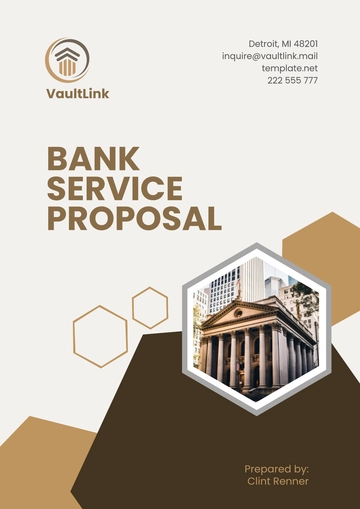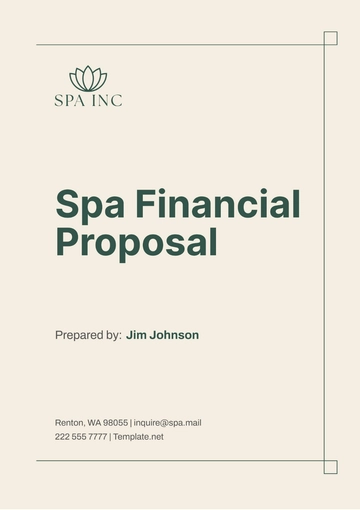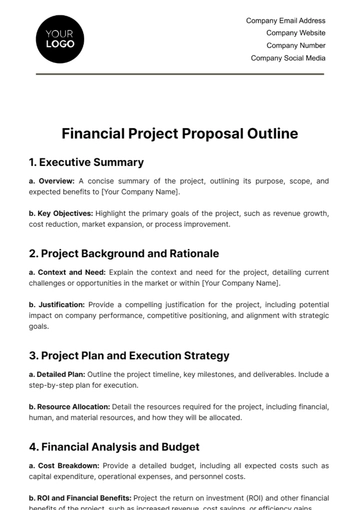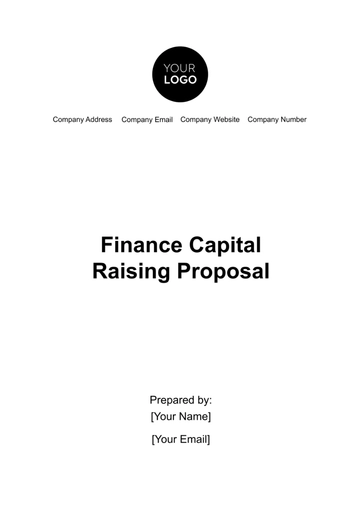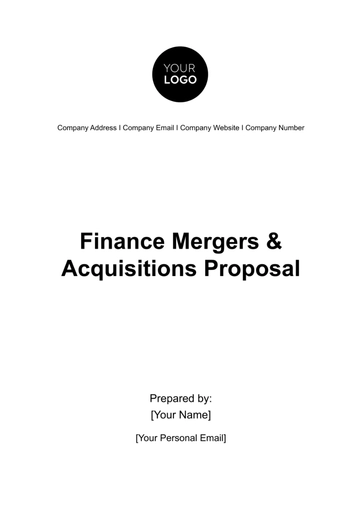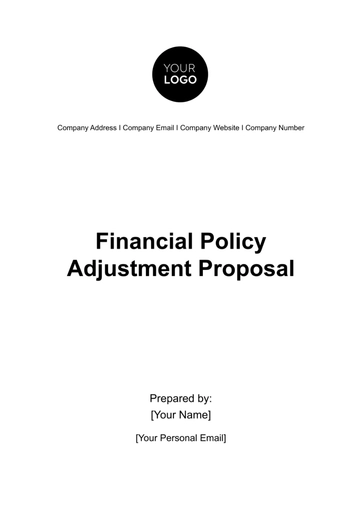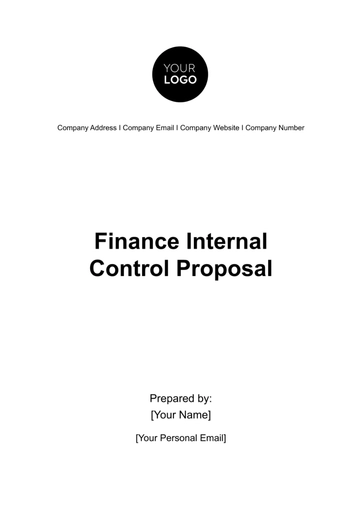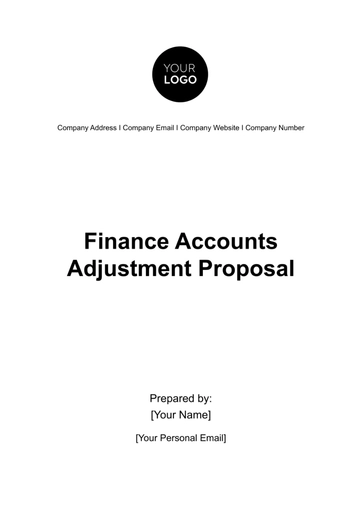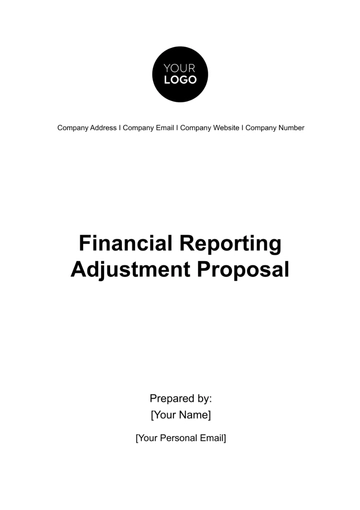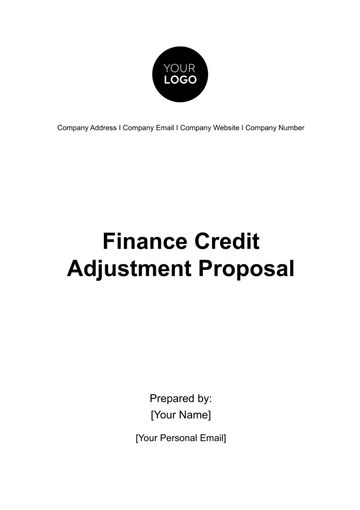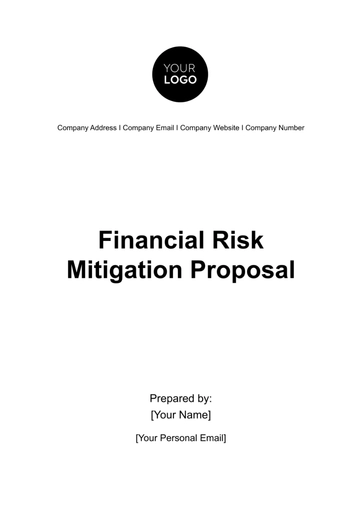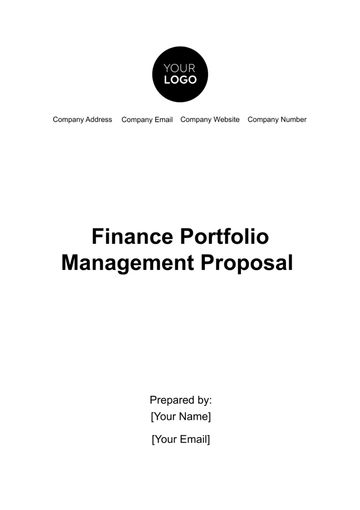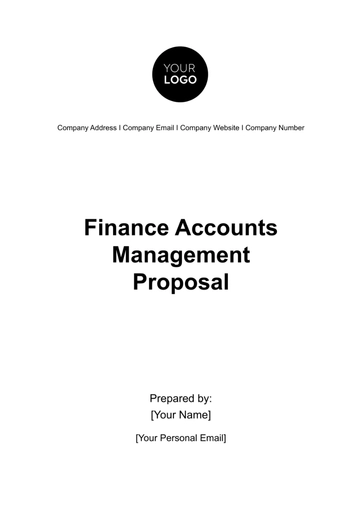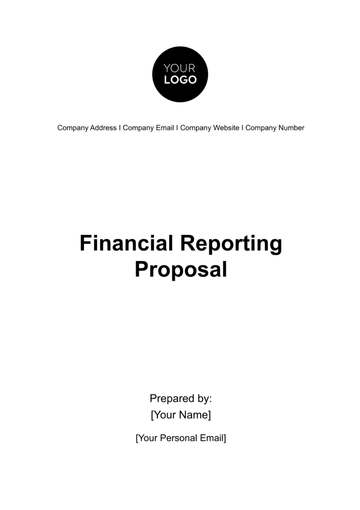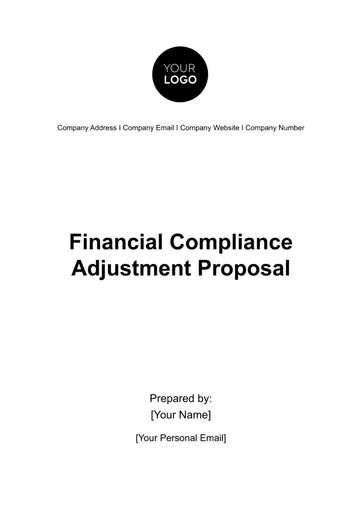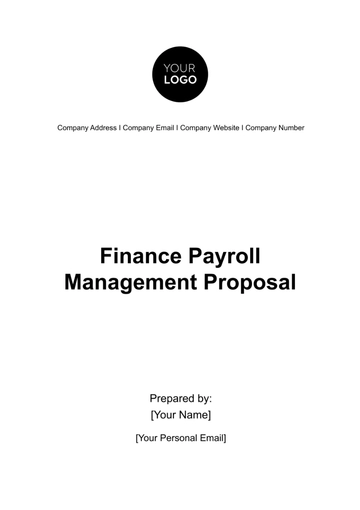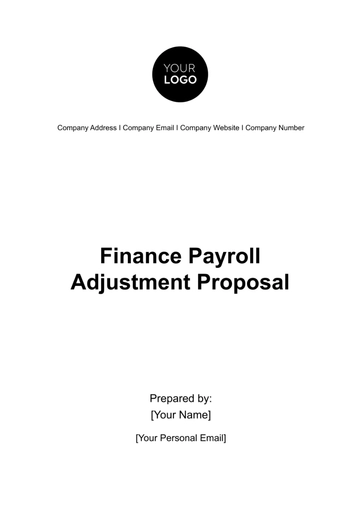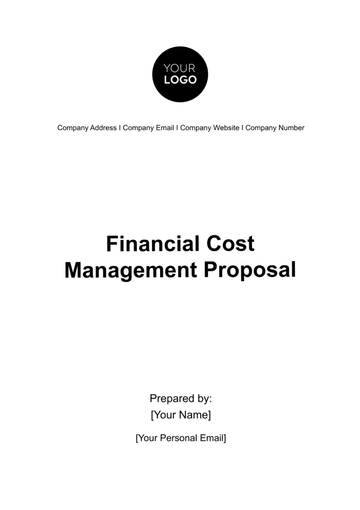Free Financial Cost Management Proposal
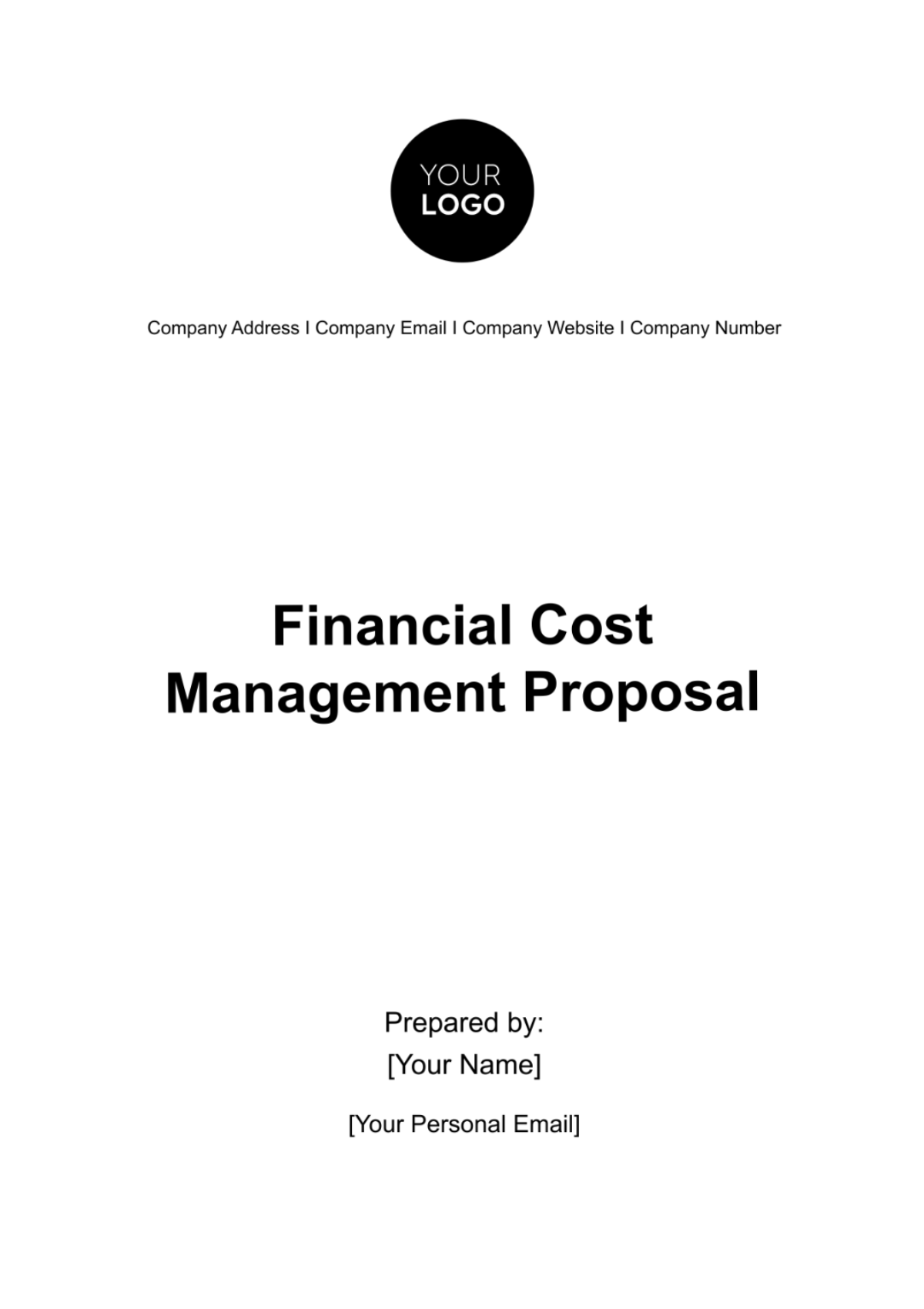
Executive Summary
[Your Company Name], a leader in innovative financial solutions, is pleased to present this Financial Cost Management Proposal to [Your Partner Company Name]. Our goal is to collaborate and implement strategies that optimize cost management, ensuring financial efficiency and sustainability for both parties.
In today's dynamic business environment, effective cost management is crucial for maintaining a competitive edge. This proposal outlines a tailored approach to identify, analyze, and optimize costs within [Your Partner Company Name]'s operations.
Key Highlights:
Proven expertise in financial optimization
Tailored solutions for [Your Partner Company Name]
Comprehensive cost analysis and reduction strategies
Commitment to a collaborative and transparent partnership
Introduction
A. Background
In the rapidly evolving business landscape, [Your Partner Company Name] recognizes the need for a strategic approach to cost management. This initiative aims to address challenges, capitalize on opportunities, and create a resilient financial foundation.
In collaboration with [Your Company Name], this proposal outlines a roadmap to enhance cost efficiency, streamline processes, and drive sustainable financial practices.
B. Objectives
The primary objectives of this Financial Cost Management initiative are:
Identify and analyze current cost structures within [Your Partner Company Name]'s operations.
Develop and implement tailored strategies to optimize costs without compromising quality.
Foster a collaborative partnership for continuous improvement in financial practices.
Through these objectives, we aim to strengthen [Your Partner Company Name]'s financial position, drive profitability, and ensure long-term sustainability.
Scope of Work
A. Cost Analysis
Our comprehensive cost analysis involves a thorough examination of [Your Partner Company Name]'s financial structure. This includes an in-depth review of operational expenses, procurement costs, and resource allocation. By leveraging historical financial data and advanced analytical tools, we will identify cost centers, analyze spending patterns, and pinpoint areas for potential savings.
Key Activities:
Detailed examination of financial statements
Identification of key cost drivers
Evaluation of historical spending patterns
B. Process Optimization
Process optimization is integral to achieving sustainable cost reductions. We will collaborate with [Your Partner Company Name] to streamline workflows, eliminate redundancies, and enhance overall operational efficiency. This may involve the adoption of new technologies, automation of manual processes, and the implementation of best practices to ensure optimal resource utilization.
Key Strategies:
Workflow analysis and redesign
Technology integration for process automation
Training programs to facilitate smooth transitions
Methodology
A. Data Collection
To ensure the accuracy and relevance of our analysis, we will employ a meticulous data collection process. This involves gathering financial data from various sources within [Your Partner Company Name]'s operations, including accounting records, procurement databases, and relevant departmental reports. The use of standardized data collection methods will guarantee consistency and reliability.
Data Sources:
Financial statements
Procurement records
Operational reports
B. Analysis Tools
Our methodology includes the utilization of cutting-edge analysis tools to extract meaningful insights from the collected data. These tools will enable us to identify trends, assess correlations, and make data-driven recommendations. The analysis will cover both quantitative and qualitative aspects, providing a comprehensive understanding of [Your Partner Company Name]'s financial landscape.
Tools Utilized:
Financial modeling software
Data visualization tools
Statistical analysis software
Cost Reduction Strategies
A. Vendor Negotiation
Effective vendor negotiation is a key component of our cost reduction strategy. We will initiate discussions with existing vendors to renegotiate terms, secure favorable pricing, and explore potential discounts. Our skilled negotiators will leverage [Your Partner Company Name]'s purchasing volume and historical relationship to achieve cost savings without compromising product or service quality.
Negotiation Tactics:
Volume-based discounts
Long-term contract negotiations
Exploring alternative suppliers for competitive pricing
B. Technology Integration
Strategic integration of cost-effective technologies is pivotal for sustainable cost reduction. We will identify opportunities to implement automation, artificial intelligence, and other technological solutions that align with [Your Partner Company Name]'s operations. This includes the adoption of software for financial management, procurement, and workflow automation.
Technological Solutions:
Automated procurement systems
Financial management software
Cloud-based collaboration tools
Implementation Plan
A. Timeline
A well-defined timeline is crucial for the successful implementation of cost reduction strategies. Our proposed timeline encompasses key milestones and activities to ensure a smooth transition. We prioritize minimal disruption to [Your Partner Company Name]'s day-to-day operations while maximizing the speed of implementation to realize immediate cost benefits.
Milestones:
Data collection and analysis
Vendor negotiation phase
Technology integration and training
Ongoing monitoring and adjustments
B. Resource Allocation
Proper resource allocation is essential for the seamless execution of our cost management initiatives. We will collaborate with [Your Partner Company Name] to allocate the necessary human, technological, and financial resources. This may include dedicated personnel for project oversight, budget allocation for technology integration, and training programs for staff.
Resource Allocation Components:
Personnel for project management
Budget allocation for technology adoption
Training programs for employees
Monitoring and Evaluation
A. Key Performance Indicators (KPIs)
Measuring the success of our Financial Cost Management initiative is essential. We propose the following key performance indicators (KPIs) to assess the impact of implemented strategies:
Cost Reduction Percentage: Quantify the percentage reduction in overall costs after the implementation of cost-saving measures. Target: A minimum of [15%] reduction within [12] months.
Operational Efficiency Improvement: Evaluate the enhancement in operational efficiency through streamlined processes and technology integration. Target: Achieve a [20%] improvement in efficiency by the end of the second quarter.
Vendor Performance: Monitor vendor performance based on negotiated terms, timely deliveries, and quality of goods or services. Target: Maintain an average vendor performance rating of [8] on a scale of 1-10.
B. Reporting
To keep [Your Partner Company Name] informed about progress and outcomes, we will provide regular, transparent reports. These reports will include a comprehensive analysis of the key performance indicators, financial metrics, and a comparison with the baseline data. Regular communication ensures that [Your Partner Company Name] is actively engaged in the process and can provide input as needed.
Reporting Frequency:
Monthly progress reports detailing cost reduction, efficiency improvements, and vendor performance.
Quarterly financial reviews with in-depth analyses and comparisons.
Ad-hoc reports for critical updates or unexpected changes.
Budget
A. Estimated Costs
The estimated costs associated with implementing the Financial Cost Management proposal are as follows:
Data Collection and Analysis: Investment in tools, personnel, and technology for thorough data collection and analysis. Estimated cost: [$50,000].
Technology Integration: Budget for the adoption of cost-effective technologies, including software licenses, training, and integration. Estimated cost: [$80,000].
Implementation and Training: Allocate funds for the implementation phase, including personnel training and adjustments to workflows. Estimated cost: [$40,000].
B. ROI Projection
Our projection indicates a substantial return on investment (ROI) within 18 months of implementing the proposed cost reduction strategies. The ROI will be calculated based on the realized cost savings, improved operational efficiency, and enhanced overall financial performance.
Risk Management
A. Identification of Potential Risks
Before the implementation of any financial cost management strategies, it's crucial to identify potential risks that may arise during the process. This includes but is not limited to:
Operational Disruptions: Possible disruptions in day-to-day operations during the implementation phase.
Resistance to Change: Employee resistance to new processes or technologies, impacting the smooth transition.
B. Mitigation Strategies
To address these risks, [Your Company Name] proposes the following mitigation strategies:
Comprehensive Communication: Clear communication plans to inform and educate employees about upcoming changes, minimizing resistance.
Phased Implementation: A phased approach to the implementation, allowing for gradual adjustments and minimizing operational disruptions.
Continuous Improvement Plan
A. Feedback Mechanism
To ensure continuous improvement and adaptability to evolving circumstances, [Your Company Name] suggests implementing a robust feedback mechanism. This includes:
Regular Surveys and Feedback Sessions: Gathering input from employees and stakeholders to identify areas of improvement and address concerns.
B. Adaptive Strategies
Based on the feedback received, [Your Company Name] commits to adapting strategies and processes. This includes:
Agile Approach: Embracing an agile methodology to swiftly respond to changing circumstances and optimize financial strategies accordingly.
Conclusion
The Financial Cost Management Proposal presented by [Your Company Name] offers a comprehensive strategy to enhance cost efficiency and financial sustainability for [Your Partner Company Name]. Through a collaborative and tailored approach, we aim to achieve mutual benefits and drive long-term success.
A. Summary of Key Benefits
Cost Optimization: The implementation of strategic cost reduction measures is projected to result in a minimum of [15%] reduction in overall costs within the first year.
Operational Efficiency: By streamlining processes and integrating cost-effective technologies, [Your Partner Company Name] can expect a 20% improvement in operational efficiency by the end of the second quarter.
Vendor Management: Our vendor negotiation strategies aim to maintain a high average vendor performance rating of 8 on a scale of 1-10, ensuring quality and timely deliveries.
B. Call to Action
We invite [Your Partner Company Name] to engage in further discussions to fine-tune the proposed Financial Cost Management strategies according to your specific needs and preferences. This collaborative effort will be pivotal in tailoring the implementation plan and ensuring seamless integration with your existing operations.
For detailed discussions or to address any queries, please feel free to contact [Your Name] at [Your Company Email] or [Your Company Number]. We look forward to the opportunity to create a robust financial foundation for [Your Partner Company Name].
[Your Company Website] | [Your Company Social Media]
- 100% Customizable, free editor
- Access 1 Million+ Templates, photo’s & graphics
- Download or share as a template
- Click and replace photos, graphics, text, backgrounds
- Resize, crop, AI write & more
- Access advanced editor
Revolutionize financial strategies with the Financial Cost Management Proposal Template from Template.net. This editable and customizable document empowers seamless crafting of tailored proposals. Effortlessly refine cost management initiatives using our Ai Editor Tool, ensuring adaptability and precision. Elevate your financial proposals with this user-friendly template, offering a dynamic approach to effective cost management strategies.
You may also like
- Business Proposal
- Research Proposal
- Proposal Request
- Project Proposal
- Grant Proposal
- Photography Proposal
- Job Proposal
- Budget Proposal
- Marketing Proposal
- Branding Proposal
- Advertising Proposal
- Sales Proposal
- Startup Proposal
- Event Proposal
- Creative Proposal
- Restaurant Proposal
- Blank Proposal
- One Page Proposal
- Proposal Report
- IT Proposal
- Non Profit Proposal
- Training Proposal
- Construction Proposal
- School Proposal
- Cleaning Proposal
- Contract Proposal
- HR Proposal
- Travel Agency Proposal
- Small Business Proposal
- Investment Proposal
- Bid Proposal
- Retail Business Proposal
- Sponsorship Proposal
- Academic Proposal
- Partnership Proposal
- Work Proposal
- Agency Proposal
- University Proposal
- Accounting Proposal
- Real Estate Proposal
- Hotel Proposal
- Product Proposal
- Advertising Agency Proposal
- Development Proposal
- Loan Proposal
- Website Proposal
- Nursing Home Proposal
- Financial Proposal
- Salon Proposal
- Freelancer Proposal
- Funding Proposal
- Work from Home Proposal
- Company Proposal
- Consulting Proposal
- Educational Proposal
- Construction Bid Proposal
- Interior Design Proposal
- New Product Proposal
- Sports Proposal
- Corporate Proposal
- Food Proposal
- Property Proposal
- Maintenance Proposal
- Purchase Proposal
- Rental Proposal
- Recruitment Proposal
- Social Media Proposal
- Travel Proposal
- Trip Proposal
- Software Proposal
- Conference Proposal
- Graphic Design Proposal
- Law Firm Proposal
- Medical Proposal
- Music Proposal
- Pricing Proposal
- SEO Proposal
- Strategy Proposal
- Technical Proposal
- Coaching Proposal
- Ecommerce Proposal
- Fundraising Proposal
- Landscaping Proposal
- Charity Proposal
- Contractor Proposal
- Exhibition Proposal
- Art Proposal
- Mobile Proposal
- Equipment Proposal
- Student Proposal
- Engineering Proposal
- Business Proposal

